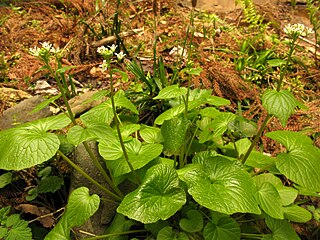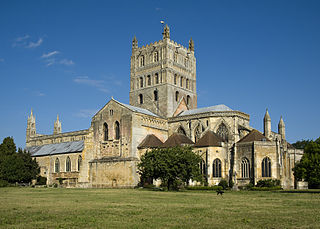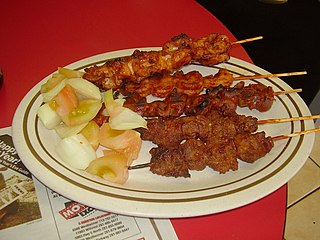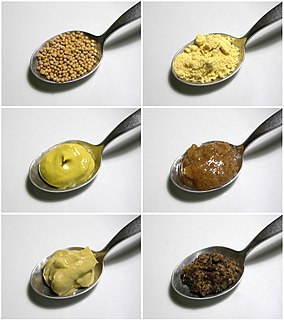Tewkesbury mustard is a blend of mustard flour and grated horseradish root. The mustard was developed in the English town of Tewkesbury in Gloucestershire, and gained a certain reputation in the 17th century, becoming a staple condiment of the kitchens of the time.
Shakespeare mentions the mustard in Henry IV, Part 2, in which Falstaff has the line: “his wit's as thick as Tewkesbury Mustard” (Act 2, Scene 4, Line 244), describing the character of his friend Ned Poins. [1]
Originally the mustard was prepared by grinding the mustard seeds into mustard flour, combining this with finely-grated horseradish (and sometimes herbs and spices), then forming the mixture into balls which were then dried to aid preservation. [2] The mustard balls would then be transported and sold in this form.
To use the balls they would be broken apart then mixed with a liquid such as water, vinegar, [3] wine, ale, beer, cider or fruit juice to soften them and mixed to a thick, creamy consistency. Often a sweetener such as honey would be added.
The resulting mixture would then be used as a condiment just as mustard is used today, or as a cure for ailments. [3]
At the time of the Tewkesbury Festival in 1971 (a major programme of events commemorating the 850th anniversary of the consecration of the Abbey and the 500th anniversary of the Battle of Tewkesbury), the mustard was recreated on a commercial basis from the original recipe, [4] though it is not made in Tewkesbury. Handmade mustard using local ingredients can still be purchased in Tewkesbury. The mustard can still be bought in ball format and even covered in gold leaf. Readily found in Tewkesbury's shops and the local mustard company 'The Tewkesbury Mustard Company' online.
There is some evidence that “Tewkesbury Mustard” came to be used as slang for incendiary 'fire-balls', a usage referred to in David Hume's History of England , in which he describes the rumour that the Great Fire of London was started by foreign arsonists trained by Jesuits "and the whole plan of operations was so concerted, that precautions were taken by the Jesuits to vary their measures, according to the variation of the wind. Fire-balls were familiarly called among them Tewkesbury mustard pills". [5] Robert Hugh Benson’s refers to this in his historical novel Oddfish!, which contains the text: “Workmen, too, were set to search and dig everywhere for "Tewkesbury mustard-balls," as they were called—or fire-balls, with which it was thought that the Catholics would set London a-fire”. [6] A similar line also appears in Alfred Marks' book Who Killed Sir Edmund Godfrey?.
Thomas Firminger Thiselton-Dyer in his book “The Folk-lore of Plants” [7] (pub. 1889) gives evidence that the phrase “He looks as if he lived on Tewkesbury mustard” came to be used as slang in Gloucestershire for those "who always have a sad, severe, and terrific countenance".
In Shakespeare's Henry IV, 2. part, Falstaff says: "He a good wit? Hang him, baboon. His wit’s as thick as Tewksbury mustard. There’s no more conceit in him than is in a mallet" (Act 2, scene 4).

Sir John Falstaff is a fictional character who appears in three plays by William Shakespeare and is eulogized in a fourth. His significance as a fully developed character is primarily formed in the plays Henry IV, Part 1 and Part 2, where he is a companion to Prince Hal, the future King Henry V of England. A notable eulogy for Falstaff is presented in Act II, Scene III of Henry V, where Falstaff does not appear as a character on stage, as enacted by Mistress Quickly in terms that some scholars have ascribed to Plato's description of the death of Socrates after drinking hemlock. By comparison, Falstaff is presented as the buffoonish suitor of two married women in The Merry Wives of Windsor.

Wasabi or Japanese horseradish is a plant of the family Brassicaceae, which also includes horseradish and mustard in other genera. A paste made from its ground rhizomes is used as a pungent condiment for sushi and other foods. It is similar in taste to hot mustard or horseradish rather than chili peppers in that it stimulates the nose more than the tongue.

Horseradish is a perennial plant of the family Brassicaceae. It is a root vegetable used as a spice and prepared as a condiment.

In cooking, a sauce is a liquid, cream, or semi-solid food, served on or used in preparing other foods. Most sauces are not normally consumed by themselves; they add flavor, moisture, and visual appeal to a dish. Sauce is a French word taken from the Latin salsa, meaning salted. Possibly the oldest recorded European sauce is garum, the fish sauce used by the Ancient Romans; while doubanjiang, the Chinese soy bean paste is mentioned in Rites of Zhou in the 3rd century BC.

Glutinous rice is a type of rice grown mainly in Southeast and East Asia and the eastern parts of South Asia, which has opaque grains, very low amylose content, and is especially sticky when cooked. It is widely consumed across Asia.

Tewkesbury is a market town and civil parish in Gloucestershire, England. It stands at the confluence of the River Severn and the River Avon, and also minor tributaries the Swilgate and Carrant Brook. It gives its name to the Borough of Tewkesbury, of which the town is the second largest settlement. It lies in the far north of the county, forming part of the border with Worcestershire.

Malay cuisine is the cooking tradition of ethnic Malays of Southeast Asia, residing in modern-day Malaysia, Indonesia, Singapore, Brunei, Southern Thailand and the Philippines. Different Malay regions are all known for their unique or signature dishes — Terengganu and Kelantan for their Nasi dagang, Nasi kerabu and Keropok lekor, Negeri Sembilan for its lemak-based dishes, Pahang and Perak for their gulai tempoyak, Kedah for its northern-style Asam laksa, Malacca for its spicy Asam Pedas, Riau for their ikan patin dishes; Gulai ikan patin and Asam Pedas ikan patin, Melayu Deli of Medan North Sumatra for their Nasi goreng teri Medan and Gulai Ketam and Brunei for its unique Ambuyat dish.

Riti raita is a condiment in South Asian cuisine made of dahi together with raw or cooked vegetables, more seldom fruit, or in the case of boondi raita, with fried droplets of batter made from besan.

Colman's is an English manufacturer of mustard and other sauces, based at Carrow, in Norwich, Norfolk. Owned by Unilever since 1995, Colman's is one of the oldest existing food brands, famous for a limited range of products, almost all varieties of mustard.

Burmese cuisine is mainly an amalgam of cuisines from various regions of Myanmar. It has also been influenced by various cuisines of neighbouring countries, in particular, China, India and Thailand.

This is a listing of regional variations on the hot dog. Different areas of the world have local variations on the type of meat used, condiments, and means of preparation, which are enumerated below.

{a}}

Gold Pure Food Products Co., Inc. is an American food-manufacturing company located in Hempstead, New York.

Mustard is a condiment made from the seeds of a mustard plant.

Telugu cuisine is a cuisine of South India native to the Telugu people from the states of Andhra Pradesh and Telangana. Generally known for its tangy, hot and spicy taste, the cooking is very diverse due to the vast spread of the people and varied topological regions.

A food paste is a semi-liquid colloidal suspension, emulsion, or aggregation used in food preparation or eaten directly as a spread. Pastes are often highly spicy or aromatic, are often prepared well in advance of actual usage, and are often made into a preserve for future use. Common pastes are some fruit preserves, curry pastes, and nut pastes. Purées are food pastes made from already cooked ingredients.

Edward "Ned" Poins, generally referred to as "Poins", is a fictional character who appears in two plays by Shakespeare, Henry IV, Part 1 and Henry IV, Part 2. He is also mentioned in The Merry Wives of Windsor. Poins is Prince Hal's closest friend during his wild youth. He devises various schemes to ridicule Falstaff, his rival for Hal's affections.
|journal= (help)|journal= (help)|journal= (help)